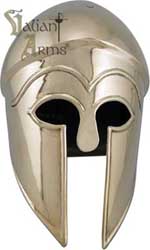Greek Helmets
Greek Helmets
 In Greek monuments, three distinct varieties of helms are depicted. One, which appears to date back from remote antiquity, consists of a close-fitting cap, a lengthened neckguard, pendant guards for the face which are attached to the cap on each side by hinges to give free movement, and an elevated visor or frontlet of a triangular pediment-like form, which in reality is simply a decoration for the front of the helm. The crest, with the panache or plume, appears under a great variety of forms, but the prevailing arrangement is for the prolonged crest to be carried from the visor to the neck-guard, and to be covered with a plume or tuft displayed like a fan.
In Greek monuments, three distinct varieties of helms are depicted. One, which appears to date back from remote antiquity, consists of a close-fitting cap, a lengthened neckguard, pendant guards for the face which are attached to the cap on each side by hinges to give free movement, and an elevated visor or frontlet of a triangular pediment-like form, which in reality is simply a decoration for the front of the helm. The crest, with the panache or plume, appears under a great variety of forms, but the prevailing arrangement is for the prolonged crest to be carried from the visor to the neck-guard, and to be covered with a plume or tuft displayed like a fan.
The second type of Greek helm may be described as a deep head-piece with a long projecting peak, visor, or nasal and at the back a deep neckguard upon the peak or visor. The nose and eyes of a human face are indicated with more or less distinctness. There seldom is any crest, but some examples are surmounted by the figure of a bird or animal.
The third variety, distinguished as the "Boetian Helm" was preferred to all others by warriors. It was a deep head-piece with neck and cheek-guards wrought into a simple solid mass, which would cover and effectually protect the wearer from the shoulders upwards, with the exception of the face only. The nasal seconded by the projection of the cheek-guards, would afford an almost perfect protection as well freedom of sight and breathing.



